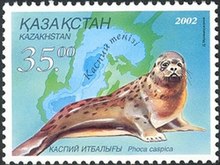Caspian seal
| Caspian seal | ||||||||||||
|---|---|---|---|---|---|---|---|---|---|---|---|---|

Caspian seal ( Pusa caspica ), dermoplasty |
||||||||||||
| Systematics | ||||||||||||
|
||||||||||||
| Scientific name | ||||||||||||
| Pusa caspica | ||||||||||||
| ( Gmelin , 1788) |
The Caspian seal ( Pusa caspica , Syn . : Phoca caspica ) is an endemic seal of the Caspian Sea .
features
Males are up to 1.5 meters long and females up to 1.4 meters. They are dark gray or yellowish gray. Males have a dark pattern of spots, while females have lighter and less visible spots on their backs.
Way of life
Within the Caspian Sea, these seals undertake seasonal migrations. In winter they stay in the northeastern part, where the water is shallower. In summer they gather in the southern parts. In doing so, they apparently also follow their prey, which consists of small fish and crustaceans.
After eleven months of gestation, the young are born in January and February. They are suckled for a month before they are abandoned by the mother, which now mates with a male.
Persistence and protection
After 160,000 Caspian seals were killed annually in the 1930s, the Soviet Union introduced hunting restrictions to protect the species from extinction. Today around 25,000 seals are hunted for their skins every year, and since the collapse of the Soviet Union there have been increasing problems with poachers. The discharge of poison into the Caspian Sea and the associated weakening of the seal's immune system contribute to the steady decline in the population.
Estimates of the total population vary widely. Originally there may have been over a million Caspian seals. In the 1980s the population was estimated at just under 400,000. By now there should only be a little over 100,000 seals. The IUCN therefore lists the Caspian seal as endangered.
literature
- Ronald M. Nowak: Walker's Mammals of the World. 6th edition. Johns Hopkins University Press, Baltimore 1999, ISBN 0-8018-5789-9
- Herodotus: Historien , first book No. 202 and note No. 161 first book, Alfred Kröner Verlag, Stuttgart, ISBN 3-520-22404-6
Web links
- Pusa caspica inthe IUCN 2013 Red List of Threatened Species . Posted by: Härkönen, T. (IUCN SSC Pinniped Specialist Group), 2008. Retrieved October 13, 2013.
